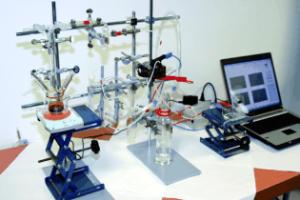|
Related Topics: |
|
Current News |
|
Chemistry A to Z |
|
About Internetchemistry |
|
- Imprint |
|
|
Power from Formic Acid |
|
One of the central challenges of our time is the supply of enough environmentally friendly and resource-efficient energy to our society. In this context, hydrogen technology has taken on increased importance. Björn Loges, Albert Boddien, Henrik Junge, and Matthias Beller at the Leibniz Institute of Catalysis in Rostock have now succeeded in the controlled extraction of hydrogen from formic acid—without the need for the high-temperature reforming process usually involved in other hydrogen generation systems. As they report in the journal Angewandte Chemie, this hydrogen source, generated at room temperature, can be directly introduced into fuel cells. |
|
Hydrogen-powered fuel cells are the cleanest source of energy because they only produce one type of exhaust gas: water vapor. However, it is not yet practicable to transport and store hydrogen, which is a gas and cannot be pumped into a tank as easily as gasoline. Storage systems currently in use are large and heavy, expensive, and complex. It would thus be better to couple the fuel cell directly to a hydrogen-producing material, which would supply the fuel cell on demand. Aside from methane and methanol, renewable resources such as biomass and its fermentation products (e.g. bioethanol) are the most promising starting materials for this technology. The serious disadvantage is that their conversion only works at temperatures above 200 °C, which consumes a significant portion of the energy produced. The researchers from Rostock have now developed a feasible process for the on-demand release of hydrogen; they produce hydrogen from formic acid (HCO2H). In the presence of an amine (e.g. N,N-dimethylhexylamine) and with a suitable catalyst (e.g. the commercially available ruthenium phosphine complex [RuCl2(PPH3)2]), formic acid is selectively converted into carbon dioxide and hydrogen at room temperature. A simple activated charcoal filter is enough to purify the hydrogen gas for use in a fuel cell. The use of formic acid for “hydrogen storage” allows the advantages of established hydrogen/oxygen fuel cell technology to be combined with those of liquid fuels. Formic acid is nontoxic and easy to store. Because formic acid can be generated catalytically from CO2 and biomass-derived hydrogen, the cycle is CO2 neutral in principle. Will we be replacing gasoline with formic acid in the future? It is not inconceivable, but initial applications requiring smaller amounts of energy are more probable. “For the use of fuel cells in portable electrical devices,” says Beller, “this nascent formic acid technology opens up new possibilities in the short term.” |
|
|
|
|
Related topics - search form: |
|
|
